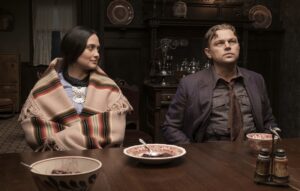The Reel Review
Two decades after the discovery of oil on their land made them the wealthiest people on Earth, a shocking spate of murders decimate the Osage Native Americans of northern Oklahoma in the early 1920s, eventually prompting a federal investigation to capture the culprits. Leonardo DiCaprio, Robert De Niro and Lily Gladstone star in this epic Western true crime drama from director Martin Scorsese. It is based on David Grann’s 2017 book about the deadly crime spree which, mostly ignored for nearly a century, spawned the creation of the modern-day FBI.

With a budget of $200 million, Killers of the Flower Moon is the most expensive biographical film ever made – and it shows. Epic in scale, Scorsese pays remarkable attention to detail and historical accuracy, transporting viewers 100 years back in time, into a post WWI-era of astounding corruption and criminality. Nearly everything in the film actually happened, as the newly wealthy Osage, restricted by a U.S. government that deemed them incompetent to manage their own wealth, were quickly targeted by an influx of white conmen and opportunists – many appointed as their guardians – looking to exploit them.

De Niro and DiCaprio both give masterful performances, the former as the villainous uncle masterminding the deaths of the Osage people he befriends and claims to love like family, the latter as his dimwitted-but-useful idiot nephew. Lily Gladstone (The Unknown Country) gives a career-defining performance as Mollie, the Osage woman initially enamored with, then wary of, her increasingly dubious white husband, with Jesse Plemons (The Power of the Dog) as the federal lawman who leads an undercover team to bring the guilty to justice.

Despite its three-and-a-half-hour runtime, the action never wanes, remaining riveting throughout. Scorsese lets his story breathe, eventually sliding into his more familiar mode of gangster storytelling in the third hour, as captured criminals turn on one another. References to the 1921 Tulsa Race Massacre and rise of the Ku Klux Klan illustrate the underlying current of white supremacy that enabled such an odious genocide to occur against the Osage. Scorsese’s epilogue is creative, finally giving the Osage some sense of justice, 100 years after the tragedy.
REEL FACTS

• The Bureau of Investigation ultimately determined that dozens of white people in Fairfax, Oklahoma — among them judges, doctors, pastors, coroners, and henchmen – conspired to kill at least 60, and possibly hundreds, of the Osage tribe’s more than 2200 members in the early 1920s.

• In 2011, the Osage Nation and U.S. government settled a long-standing lawsuit for alleged government mismanagement of Osage oil revenues for $380 million dollars. Attorneys for the Osage called it the largest settlement ever between the government and a single tribe.

• Filmed in Osage and Washington counties, Killers of the Flower Moon employed Osage consultants and cultural advisors to ensure historical accuracy in the film.



